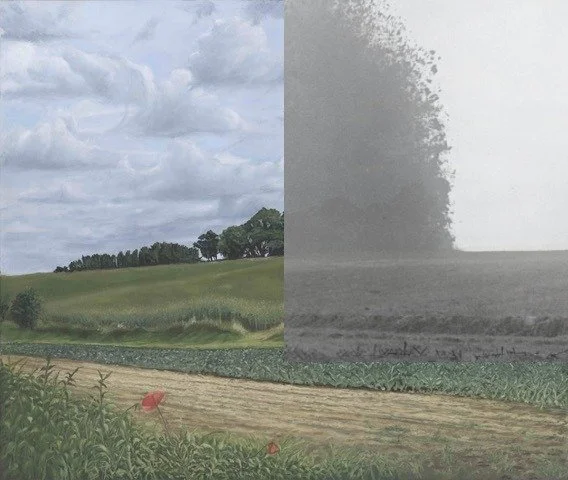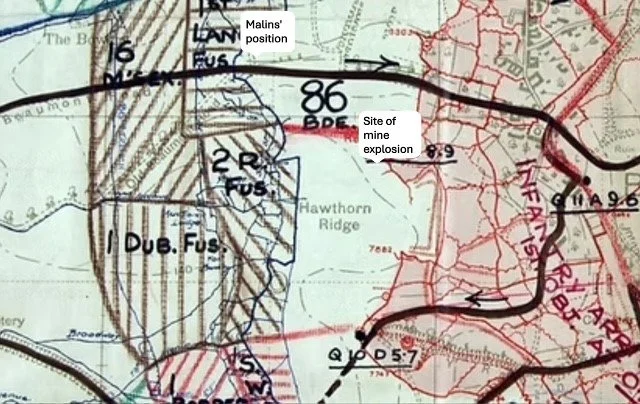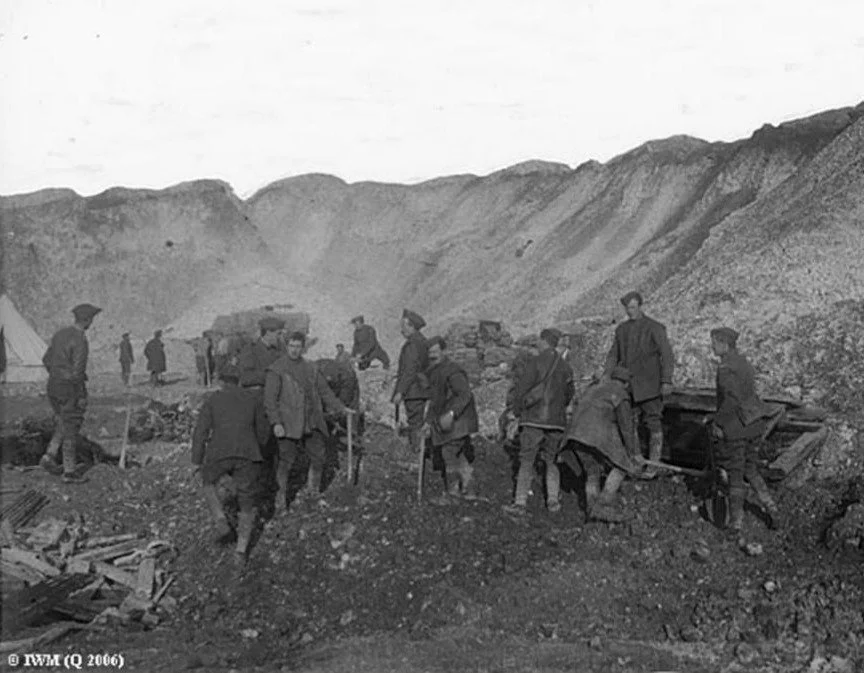Hawthorn Ridge painting with mine explosion overlaid (Image IWM)
Malins’ footage of the mine explosion, July 1st 1916 (Image IWM)
‘The ground where I stood gave a mighty convulsion. It rocked and swayed. I gripped hold of my tripod to steady myself. Then for all the world like a gigantic sponge, the earth rose high in the air to the height of hundreds of feet. Higher and higher it rose, and with a horrible grinding roar the earth settles back upon itself, leaving in its place a mountain of smoke’. Malins
Troop positions for the attack on Hawthorn Ridge
Hawthorn Ridge was a strategic high point on the German front line. To secure the position, British troops tunnelled deep underground and laid explosives. On the morning of 1st July 1916 there was an enormous explosion throwing tonnes of earth high into the air and leaving behind a huge crater. Soldiers from the Middlesex Regiment and Royal Fusiliers rushed forwards to take the crater but German soldiers had regrouped quickly and held their front line.
Malins knew that the explosion was imminent. He took over 1000’ of film to ensure he got exactly the right shot. He was successful and incredibly, he captured the exact moment of the explosion spewing tonnes of soil high into the air. The huge crater can still be seen today.
Simon wanted to capture the woodland now growing from the crater on Hawthorn Ridge as a memorial to the men of the Middlesex Regiment and Royal Fusiliers. It demonstrates how despite carnage and death, the landscape will restore itself and heal.
The painting (oil on canvas-panel) shows Hawthorn Ridge as it looked in the summer of 2024.
“Whilst sketching this scene there was a constant stream of tractors and trailers going past bringing in the harvest. It reminds us that this is, and has always been, very productive farmland - only these days it also produces ‘The Iron Harvest’. This is war debris: pieces of shrapnel, live shells, unexploded grenades - you name it! It is estimated that about 1.5 billion shells were fired on the Western Front during the 1914-18 war and perhaps 30 percent of them didn’t explode”
Simon Reeves
After filming the mine explosion Malins swung his camera to the right and captured men of the Royal Fusiliers / Middlesex Regiment attacking the crater moving across no-man’s land. It is the only footage of men attacking on the 1st day of the battle of the Somme. It may have been edited to avoid showing so many men falling in action.
Authentic film of the 2nd Royal Fusiliers / 16th Middlesex Regiment attacking Hawthorn Ridge crater on 1st July 1916 (Image IWM)
Men working in the mine crater in November 1916 (Image IWM)
About Malins
Geoffrey Malins was commissioned to capture film and photographs of the war. In 1916 he was attached to the British Army on the first day of the battle of the Somme. He gathered many hours of footage which was edited into a 77 minute documentary shown in cinemas back home.
The film was controversial in that it showed images of dead soldiers and Malins was unsure how the public would react. He decided to keep the images in as ‘it is only a very mild touch of what is happening day after day, week after week, on the bloody plains of France and Belgium…’. The public evidently saw it as their duty to view the film, with over 20 million viewings in the following months.
The work was dangerous and Malins was eventually invalided away from battle, having been wounded twice, deafened and gassed. He was awarded an OBE in June 1918 in recognition of his work as official photographer ‘in circumstances of great difficulty and danger’.



